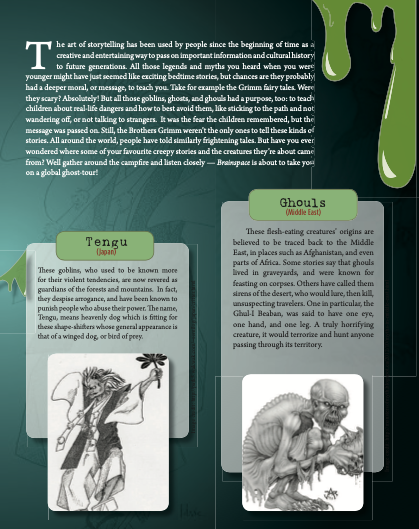
The art of storytelling has been used by people since the beginning of time as a creative and entertaining way to pass on important information and cultural history to future generations. All those legends and myths you heard when you were younger might have just seemed like exciting bedtime stories, but chances are they probably had a deeper moral, or message, to teach you. Take for example the Grimm fairy tales. Were they scary? Absolutely! But all those goblins, ghosts, and ghouls had a purpose, too: to teach children about real-life dangers and how to best avoid them, like sticking to the path and not wandering offff, or not talking to strangers. It was the fear the children remembered, but the message was passed on. Still, the Brothers Grimm weren’t the only ones to tell these kinds of stories. All around the world, people have told similarly frightening tales. But have you ever wondered where some of your favourite creepy stories and the creatures they’re about came from? Well gather around the campfire and listen closely — Brainspace is about to take you on a global ghost-tour!



The Snarly Yow (United States)
Reports of this apparition date back to the late 1700s, where it was claimed that The Snarly Yow, a large, black dog, would haunt South Mountain, close to Hagerstown, Maryland, terrorizing travelers. Recorded accounts say that the Snarly Yow would spook horses, then vanish after the rider had been thrown off. Many attempted to throw rocks at the dog to scare it away, and some even tried shooting it, but it didn’t matter- it all went right through him! The last recorded sighting of the Snarly Yow was in 1975.
.
Knockers (England)
A form of goblin known for living in the mines of Cornwall, Knockers have been said to be both helpful and harmful to the humans around them, depending on whether or not they feel respected. Their name comes from the noise they make when they either aid or create mischief. If they feel respected by the miners, they will knock when they come across gold, or as a warning that a cave-in is about to occur. If unappreciated, they knock to cause the cave-in.
.
Tengu (Japan)
These goblins, who used to be known more for their violent tendencies, are now revered as guardians of the forests and mountains. In fact, they despise arrogance, and have been known to punish people who abuse their power. The name, Tengu, means heavenly dog which is fitting for these shape-shifters whose general appearance is that of a winged dog, or bird of prey.
.
Ghouls (Middle East)
These flesh-eating creatures’ origins are believed to be traced back to the Middle East, in places such as Afghanistan, and even parts of Africa. Some stories say that ghouls lived in graveyards, and were known for feasting on corpses. Others have called them sirens of the desert, who would lure, then kill, unsuspecting travelers. One in particular, the Ghul-I Beaban, was said to have one eye, one hand, and one leg. A truly horrifying creature, it would terrorize and hunt anyone passing through its territory.
.
The Dungarvon Whooper (Canada)
There are many variations of this Canadian ghost story, but the most common tales say it is based on an incident that took place in a New Brunswick logging camp in the 19th century. Ryan, a newly-hired cook, came to the camp with a large amount of money in tow. One day when the loggers returned from their work in the woods, they found Ryan dead, his money gone, and the camp boss as the only witness, claiming Ryan’s death to be a freak accident. With a snowstorm brewing, the loggers were forced to bury Ryan in a shallow grave. That night, a deep and wailing whoop haunted the loggers throughout the camp. The next morning, the loggers fled in terror. To this day, some claim they can still hear the Dungarvon Whooper’s frightening calls when they are in the area.

